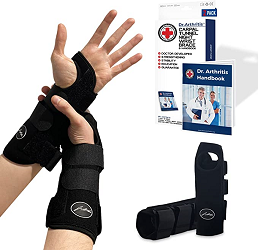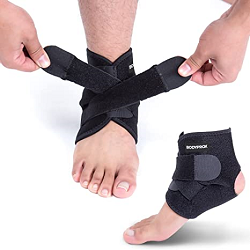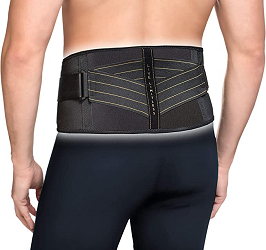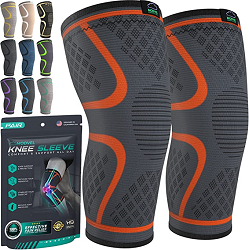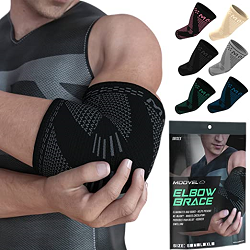Braces, Supports
Shop The Dr. Arthritis Doctor Developed Copper Wrist Brace
(#ad) Resting splint for carpal tunnel, arthritis, rsi, tendonitis or tendinopathy, ganglion cyst or a wrist sprain / strain, our wrist brace will provide symptom relief ...
Shop The Bodyprox Ankle Support Brace, Breathable Neoprene Sleeve, Adjustable Wrap
(#ad) One size fits both feet and up to 11" in feet arch circumference. Breathable neoprene material retains heat and prevents skin irritation ...
Shop The Copper Fit Pro Back Belt Compression Brace, Small/Medium
(#ad) 89% polyester / 11% spandex, Unisex Waist Size 28”-39”, compression garment for maximum lower back muscle support ...
Shop The Modvel Knee Braces for Knee Pain Women & Men
(#ad) Material: Spandex, Nylon, Latex Fiber - Specific Uses For Product Acl, Arthritis, Blend, Knee Relief, Meniscus Tear, Pain Relief, Swelling ...
Shop The MODVEL Elbow Brace - Compression Support Sleeve
(#ad) For Pain & Injuries: Pain and discomfort caused by swelling, tennis and golf elbow, tendonitis, and other related injuries ...
The Types of Braces and How to Use Them Properly: A Comprehensive Guide
Braces can be essential tools for providing support, stability, and pain relief during recovery from an injury or surgery. In this article, we will explore the different types of braces for back, elbows, knees, and ankles, and discuss how to use them properly to ensure maximum benefits.
1. Back Braces
Back braces are designed to provide support and stability for the spine, helping to alleviate pain and promote healing. There are two main types:
Rigid braces: These braces are made from rigid materials, such as plastic or metal, and are used to immobilize the spine after surgery or a severe injury.
Soft braces: These braces are made from elastic materials and provide support for less severe conditions, such as muscle strains or mild spinal deformities.
How to use a back brace properly:
Consult your healthcare provider to determine the appropriate brace for your specific condition.
Ensure the brace fits snugly around your torso and is adjusted according to your healthcare provider's instructions.
Wear the brace as recommended, typically for a few hours per day or during activities that may aggravate your condition.
2. Elbow Braces
Elbow braces are designed to provide support and stability to the elbow joint, often used in cases of tendinitis, tennis elbow, or golfer's elbow. Common types include:
Elbow straps: These are adjustable bands worn just below the elbow, providing targeted compression to help alleviate pain and inflammation.
Sleeves: These are made from elastic materials and provide gentle compression and support to the entire elbow joint.
How to use an elbow brace properly:
Consult your healthcare provider to determine the appropriate brace for your specific condition.
Ensure the brace fits snugly around your arm, without restricting circulation.
Wear the brace as recommended, typically during activities that may aggravate your condition or during the healing process.
3. Knee Braces
Knee braces are designed to provide support and stability to the knee joint, helping to alleviate pain and promote healing from injuries or surgery. There are several types:
Functional braces: These braces provide support to an injured knee, helping to stabilize and protect the joint during the healing process.
Prophylactic braces: These braces are worn to prevent knee injuries, often used by athletes during high-impact sports.
Rehabilitative braces: These braces are used after surgery or a severe injury to limit knee movement while the joint heals.
Unloader braces: These braces are designed to alleviate pain and pressure on the knee joint caused by arthritis or other degenerative conditions.
How to use a knee brace properly:
Consult your healthcare provider to determine the appropriate brace for your specific condition.
Ensure the brace fits snugly around your knee, without restricting circulation.
Wear the brace as recommended, typically during activities that may aggravate your condition or during the healing process.
4. Ankle Braces
Ankle braces are designed to provide support and stability to the ankle joint, helping to alleviate pain and promote healing from injuries such as sprains or strains. Common types include:
Lace-up braces: These braces provide adjustable compression and support, often used to prevent ankle injuries or provide support during recovery.
Stirrup braces: These braces have rigid supports on either side of the ankle, offering maximum stability while allowing for some movement.
Sleeves: These are made from elastic materials and provide gentle compression and support to the entire ankle joint.
How to use an ankle brace properly:
Consult your healthcare provider to determine the appropriate brace for your specific condition.
Ensure the brace fits snugly around your ankle, without restricting circulation.
Wear the brace as recommended, typically during activities that may aggravate your condition or during the healing process.
In conclusion, braces are essential tools for providing support and stability during recovery from various injuries or surgeries. By selecting the appropriate brace for your specific condition and using it properly, you can maximize the benefits and promote a faster, safer recovery. Always consult your healthcare provider before using any type of brace to ensure it is suitable for your unique needs.

